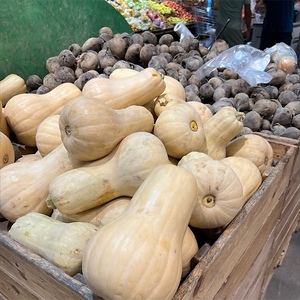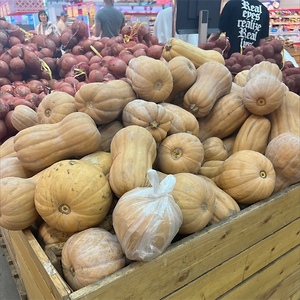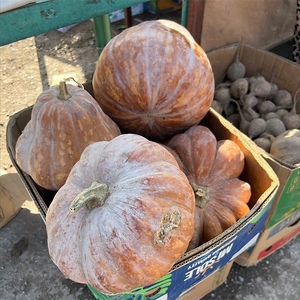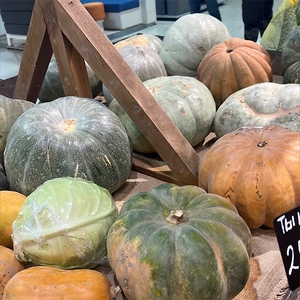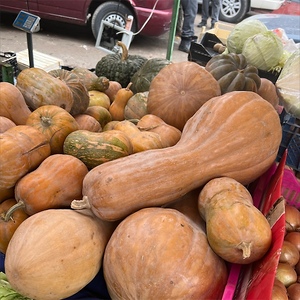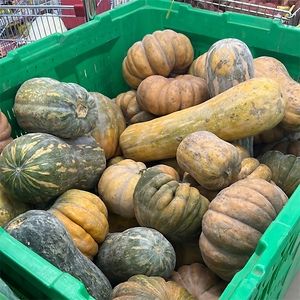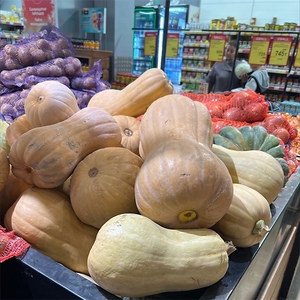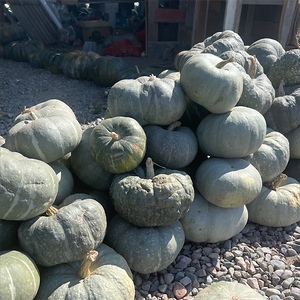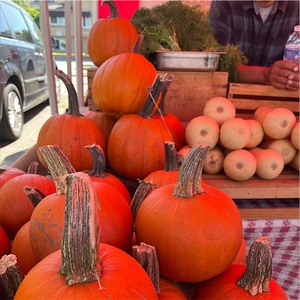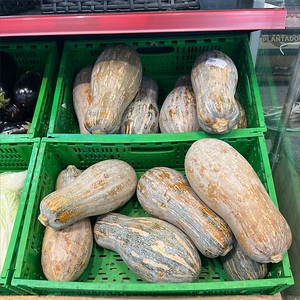


Pumpkins Small (6-10lbs)
Estimated Inventory, 24" Bin : 0
This item was last sold on : 11/27/24
Description/Taste
Pumpkins range in size from small, averaging five pounds, to extremely large, averaging over one thousand pounds and can be squat and flat to round and globular in shape. The rind varies from deeply lobed, slightly bumpy, smooth, to vertically lined with ridges, and the stems are prickly, firm, green-brown, and angular in shape. Pumpkins can be found in varying colors besides the classic orange including light green, dark green, white, red-orange, to blue-gray. The flesh is dense, thick, and pale orange, bright orange, yellow, or white, and encases a central cavity filled with pulp and flat, cream-colored seeds. Depending on the variety, when cooked, Pumpkins are tender with mild, earthy, nutty, and sweet flavors.
Seasons/Availability
Pumpkins are typically available in the fall through early winter.
Current Facts
Pumpkins belong to the Cucurbitaceae family along with squash and gourds. There are several different species within this family that varieties of Pumpkins belong to, and Pumpkins are a fruit growing on wide-spreading vines that are prepared as a vegetable in cultures across the world. Pumpkins have been cultivated since ancient times and were historically grown for eating. It wasn’t until the 1970’s that a new variety was developed specifically for carving. Today, Pumpkins are used as an ornamental decoration for fall displays and crafts, carved to celebrate legends and tradition, or are cooked and consumed in sweet and savory culinary preparations. They are also a popular item to plant in backyards because of their vigorous growth habits, beauty, and prolific nature.
Nutritional Value
Pumpkins contain magnesium, potassium, vitamin A, and antioxidants. Like many orange fruits and vegetables, Pumpkins are also rich in beta-carotene which helps support healthy eyesight and is beneficial to bone and cell development. Pumpkin seeds offer protein, iron, and zinc.
Applications
Pumpkins are best suited for cooked applications such as roasting, baking, sautéing, steaming, boiling, grilling, and frying. They can be added to curries and stir-fries, pureed and added to soups, stews, and casseroles, placed in green salads, empanadas, and quesadillas, or stuffed with vegetables, cheese, and meat and baked whole. Pumpkins can also be used to make beer and other non-alcoholic beverages. In addition to savory dishes, Pumpkins can be used in sweet preparations including quick bread, muffins, cookies, puddings, custards, tarts, cakes, and pies. Pumpkin seeds, known as pepitas, may be roasted and enjoyed as a snack. Pumpkins pair well with potatoes, broccoli, zucchini, Brussel sprouts, carrots, green beans, swiss chard, kale, dried cranberries, walnuts, hazelnuts, pine nuts, garlic, shallots, onion, sage, rosemary, thyme, cinnamon, cloves, nutmeg, cardamom, coconut oil, sausage, turkey, rice, quinoa, Gruyere cheese, parmesan cheese, mozzarella, and French bread. Pumpkins will keep 1-6 months, depending on the variety, and should be stored in a cool and dry place or the refrigerator.
Ethnic/Cultural Info
Pumpkins are most well-known for their ability to be transformed into Jack-O-Lanterns during Halloween. The tradition of pumpkin carving dates back centuries ago to an Irish myth about a man named "Stingy Jack." Legend has it that Jack tricked the Devil while he was alive, but when he passed away, he was banished to roam the Earth for eternity by the light of a burning coal in a carved-out turnip. This carved turnip became known as "Jack of the Lantern," and in Scotland and Ireland, families continued the tradition of carving root vegetables, including turnips and potatoes, with scary faces. The carved vegetables would be lit with a candle and placed on a windowsill to ward off evil spirits. Later, when colonists arrived in the New World, they started carving pumpkins, eventually becoming the item of choice for annual carvings.
Geography/History
Pumpkins are believed to be native to Central America, especially to Mexico, and date back to 7000-5500 BCE. They were then spread to the rest of the world via explorers, expeditions, and trade routes, and throughout the years farmers have cross-pollinated different varieties of Pumpkins to create new cultivars to meet market demand. Today Pumpkins can be found on every continent except for Antarctica, and are commonly found at farmers markets, specialty grocers, and through online seed catalogs for home gardens.
Recipe Ideas
Recipes that include Pumpkins Small (6-10lbs). One



